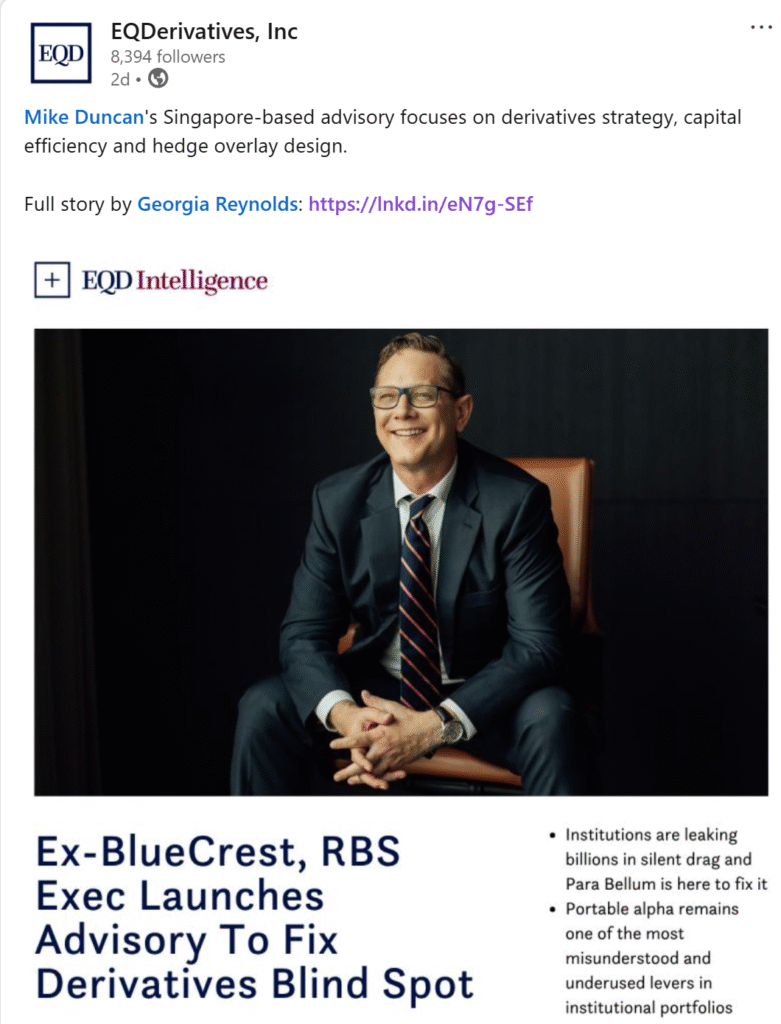
Ex-BlueCrest, RBS Exec Launches Advisory to Fix Derivatives Blind Spot
Originally published on EQD Intelligence (subscriber access required). Full interview reproduced here with permission.
- Institutions are leaking billions in silent drag – and Para Bellum is here to fix it
- Portable alpha remains one of the most misunderstood and underused levers in institutional portfolios
Launching Para Bellum Advisors
Mike Duncan, a veteran structurer with stints at BlueCrest, RBS Capital Resolution, AIA and Singlife, has launched Para Bellum Advisors – a Singapore-based advisory firm focused on derivatives strategy, capital efficiency, and hedge overlay design for institutional investors across the Asia Pacific and the Middle East.
The “Engine Room Rot” in Buyside Portfolios
Targeting sophisticated asset owners – from superannuation funds and insurers to family offices – Para Bellum Advisors exists to fix what Duncan called the “engine room rot” in many buyside portfolios.
“There are a lot of incredibly dumb things happening on the buyside every day, and they’re costing serious basis points. I’ve seen portfolios lose 100 basis points a year just from posting the wrong collateral – and no one’s questioned it in a decade. Then there’s bad hedging, using the wrong instruments and relying on processes that were flawed 20 years ago.”
Structural Inefficiencies That Persist
According to Duncan, structural inefficiencies – such as misaligned hedges, outdated credit support annexes and poor collateral execution – have gone unchallenged for years because they’re embedded in legacy processes.
“A lot of institutional workflows were designed before derivatives markets matured. Now, there’s a growing disconnect between portfolio intent and instrument design – and it’s costing firms dearly. Worse still, many firms have no idea how much they’re leaving on the table,” he said.
The CSA Shift and Regulatory Pressures
When asked if more asset owners are reassessing their capital structures and CSA terms, Duncan notes a gradual but noticeable shift.
“Five years ago, most CIOs wouldn’t touch a CSA. Today, they’re realizing they can’t afford not to,” he said. Rising funding costs, stricter regulations and heightened governance scrutiny are driving the change.
“Standardized Approach to Counterparty Credit Risk, in particular, has a deeper impact than many understand, even if you’re not directly regulated. If you use over-the-counter derivatives with banks – which most do – you’re caught indirectly.”
Portable Alpha Misconceptions
One strategy Duncan believes is chronically overlooked is portable alpha.
“Portable alpha has a terrible name – but incredible power. It’s not leverage for leverage’s sake. It’s about using modern tools to separate beta from alpha, free up capital and extract more from the same portfolio.”
He said the biggest misconception is it’s a risky, hedge fund-only play.
“It’s about replication and redeployment – turning a passive beta sleeve into a dual engine strategy, without breaching your strategic asset allocation.”
Why Portable Alpha Is Back in the Spotlight
Duncan said inquiries around portable alpha have surged in the last year – especially from teams under performance pressure who can’t tweak their asset allocation.
“What’s driving it is simple: constrained capital, expensive markets and CIOs realising they can’t cut their way to performance. Portable alpha is back in the spotlight – because it works. If you do it properly.”
Practical Example: Restructuring USD100m
In practical terms, Duncan said Para Bellum helps clients replicate index exposure via futures or total return swaps – often requiring just 5–7% margin – freeing up 90% or more of the capital tied to traditional beta positions.
“That freed capital is then redeployed into uncorrelated alpha strategies such as convex macro, market-neutral or volatility overlays, while a portion is retained in liquid reserves for risk management and collateral flexibility,” he said.
In a recent client engagement, Duncan said Para Bellum helped restructure a USD100 million passive equity allocation using equity index futures – requiring just USD6 million in initial margin.
“That freed up over USD90 million in dormant capital,” Duncan said. “We reallocated around USD30 million to alpha strategies [such as] convex macro and volatility overlays and held the remainder in liquid instruments – including Treasury bills, repo and reverse repo for tactical cash and collateral.”
The result saw over 250 basis points in improved return on capital, without taking on any additional directional risk – plus increased liquidity.
Why Para Bellum Is Different
Para Bellum doesn’t see itself as a traditional consultant – it’s a tactical partner for market practitioners.
“Everyone talks about returns, but hardly anyone talks about capital – even when there’s no regulatory charge. But capital should still be treated like the precious thing it is. That’s where you boost returns – with the same or even less risk. That’s exactly what we’re here to fix.”
Want Similar Results?
At Para Bellum, we specialise in eliminating performance drag and unlocking trapped capital – so your portfolio works harder without increasing risk.
The original article is available on EQD Intelligence (subscriber access required).
